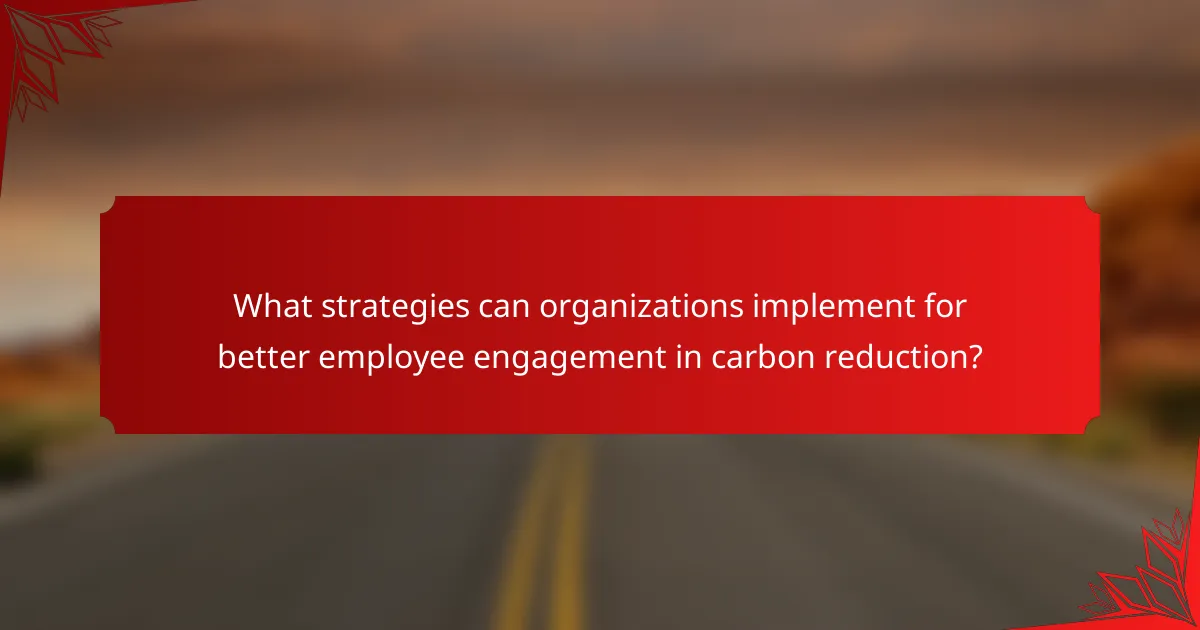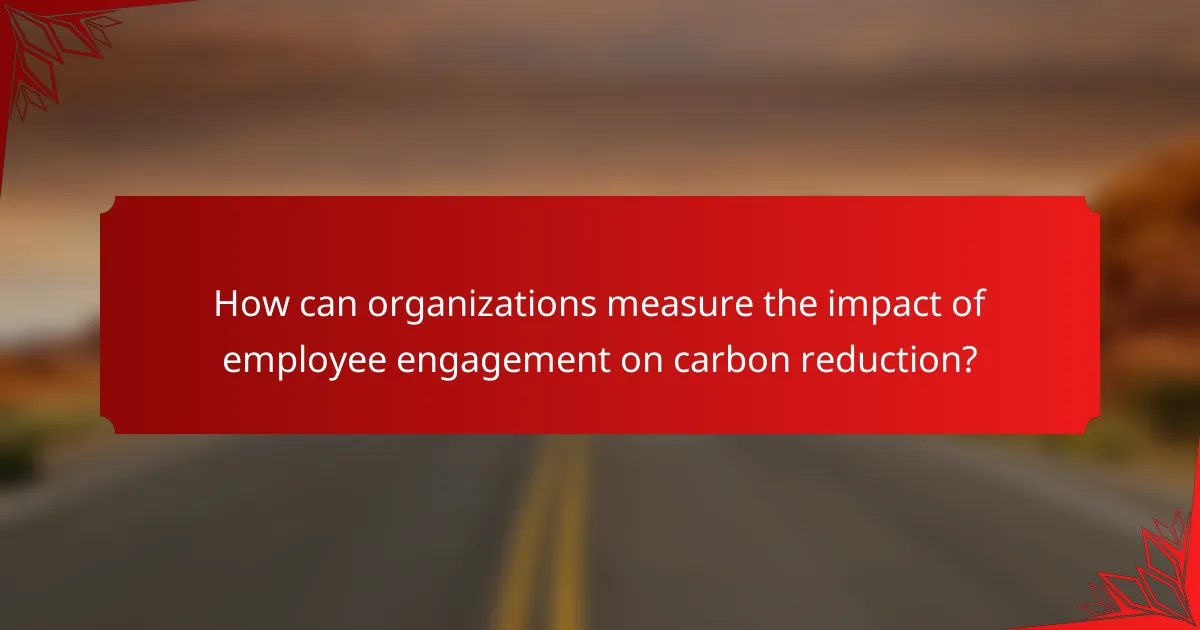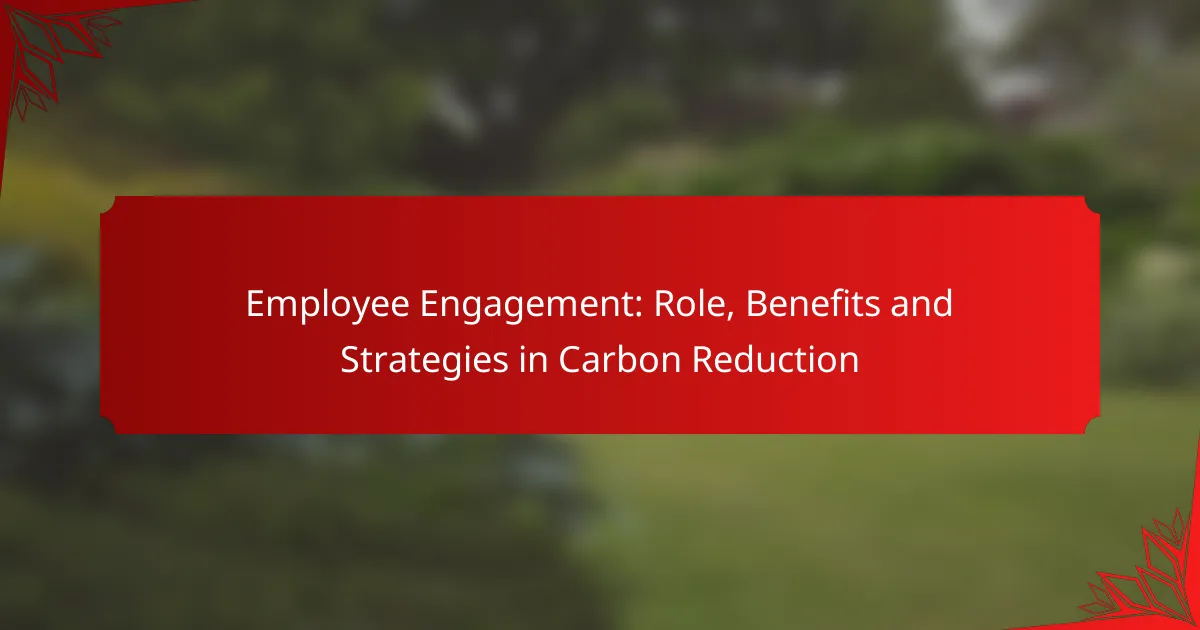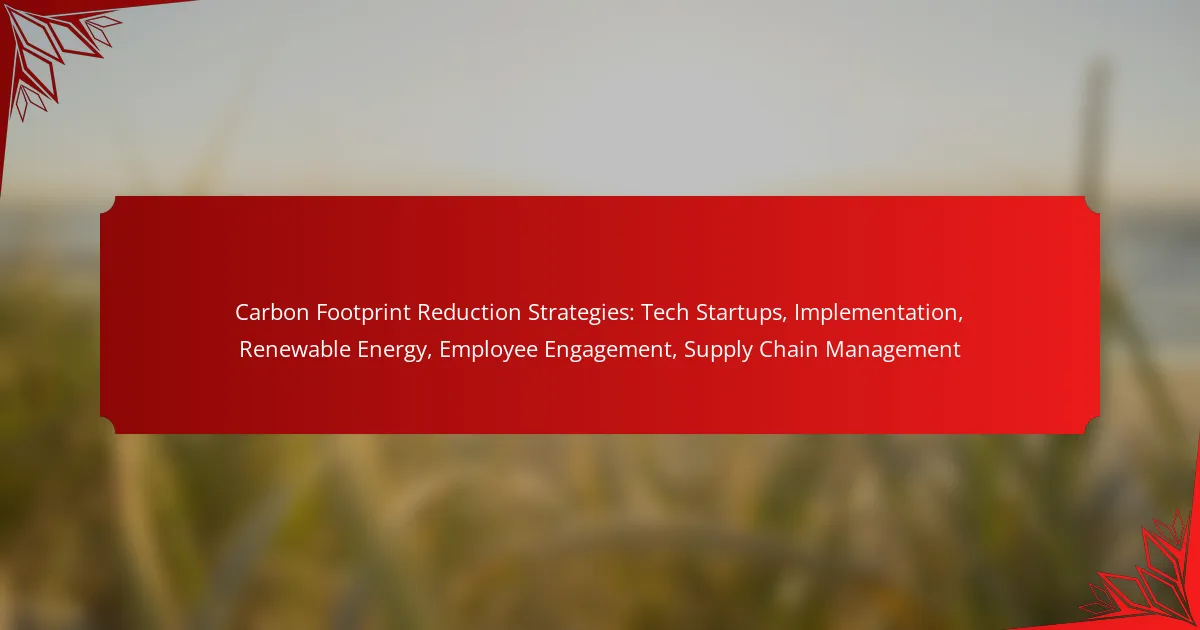Employee engagement plays a crucial role in advancing carbon reduction initiatives within organizations by cultivating a culture of sustainability. When employees are actively involved, they not only contribute innovative solutions but also take ownership of eco-friendly practices, resulting in significant reductions in carbon footprints and enhanced organizational performance.

How can employee engagement drive carbon reduction in organizations?
Employee engagement can significantly enhance carbon reduction efforts in organizations by fostering a culture of sustainability. When employees are actively involved, they contribute innovative ideas and take ownership of eco-friendly practices, leading to measurable reductions in carbon footprints.
Increased motivation for sustainability initiatives
Engaged employees are more likely to support and participate in sustainability initiatives. This motivation can stem from personal values aligning with the organization’s goals, creating a sense of purpose that drives action. For example, companies that offer incentives for green behaviors, such as rewards for using public transport or reducing energy consumption, often see higher participation rates.
To maximize motivation, organizations should communicate the impact of these initiatives clearly. Sharing success stories and data on carbon reductions can inspire employees to contribute actively and feel part of a larger mission.
Enhanced collaboration on eco-friendly projects
Collaboration among employees is crucial for the success of eco-friendly projects. Engaged teams are more likely to share ideas and resources, leading to innovative solutions for carbon reduction. For instance, cross-departmental teams can work together to implement recycling programs or energy-efficient practices that benefit the entire organization.
Encouraging open communication and providing platforms for idea sharing can enhance collaboration. Regular brainstorming sessions or sustainability workshops can help generate enthusiasm and collective ownership of environmental goals.
Improved retention of environmentally conscious talent
Organizations that prioritize employee engagement in sustainability are more likely to retain environmentally conscious talent. Employees who see their values reflected in their workplace are less likely to seek opportunities elsewhere. This retention can lead to a more experienced workforce that is committed to ongoing carbon reduction efforts.
To attract and keep such talent, companies should highlight their sustainability achievements in recruitment efforts and maintain clear policies that support environmental initiatives. Regular feedback and recognition of employees’ contributions to sustainability can further enhance loyalty and commitment.

What are the benefits of employee engagement in carbon reduction?
Employee engagement in carbon reduction initiatives leads to numerous advantages, including enhanced organizational reputation, cost savings, and improved compliance with environmental regulations. Actively involving employees fosters a culture of sustainability that can significantly impact a company’s overall performance and public perception.
Boosted organizational reputation
Engaging employees in carbon reduction efforts can significantly enhance an organization’s reputation. Companies that prioritize sustainability often attract environmentally conscious consumers and investors, leading to increased brand loyalty and market share.
For example, businesses recognized for their green initiatives may receive awards or certifications, further solidifying their status as industry leaders. This positive image can also improve employee morale and retention, as workers take pride in contributing to a responsible organization.
Cost savings through efficient resource use
Employee engagement in carbon reduction can lead to substantial cost savings by promoting efficient resource use. When employees are involved in sustainability initiatives, they often identify waste reduction opportunities, such as minimizing energy consumption or optimizing material use.
For instance, companies that implement energy-saving measures, like LED lighting or energy-efficient appliances, can see reductions in utility bills by 10-30%. Encouraging employees to adopt sustainable practices at work can also translate into lower operational costs.
Stronger compliance with environmental regulations
Involving employees in carbon reduction strategies can enhance compliance with environmental regulations. Engaged employees are more likely to understand and adhere to relevant laws, such as the Clean Air Act or local waste management regulations, reducing the risk of fines and penalties.
Training programs that educate staff on sustainability practices and compliance requirements can further strengthen this commitment. By fostering a culture of accountability, organizations can ensure that all team members contribute to maintaining high environmental standards.

What strategies can organizations implement for better employee engagement in carbon reduction?
Organizations can enhance employee engagement in carbon reduction by integrating sustainability into their core practices, providing relevant training, and establishing incentive programs. These strategies not only foster a culture of environmental responsibility but also empower employees to take actionable steps towards reducing carbon footprints.
Incorporating sustainability into company culture
Embedding sustainability into the company culture involves making it a fundamental part of the organization’s values and mission. This can be achieved by promoting eco-friendly practices in daily operations and encouraging employees to adopt sustainable behaviors both at work and home.
For example, companies can implement policies that prioritize energy efficiency, waste reduction, and sustainable sourcing. Regular communication about sustainability goals and achievements can further reinforce this commitment and motivate employees to participate actively.
Offering training and development on environmental practices
Training programs focused on environmental practices equip employees with the knowledge and skills needed to contribute to carbon reduction efforts. These programs can cover topics such as energy conservation, waste management, and sustainable transportation options.
Workshops, online courses, and hands-on training sessions can be effective formats. Organizations should consider tailoring training to different roles within the company to ensure relevance and maximize impact.
Creating incentive programs for green initiatives
Incentive programs can significantly boost employee participation in green initiatives by rewarding sustainable behaviors. These can include recognition programs, bonuses, or even competitions that encourage teams to reduce their carbon footprints.
For instance, companies might offer prizes for the department that achieves the highest recycling rates or for individuals who adopt carpooling or biking to work. Clear criteria and transparent tracking of progress can enhance the effectiveness of these programs.

What role does leadership play in fostering employee engagement for carbon reduction?
Leadership plays a crucial role in fostering employee engagement for carbon reduction by setting the tone and direction for sustainability initiatives. Effective leaders inspire their teams to actively participate in eco-friendly practices, creating a culture that prioritizes environmental responsibility.
Setting a clear vision for sustainability
Establishing a clear vision for sustainability helps employees understand the organization’s goals regarding carbon reduction. Leaders should articulate specific, measurable objectives that align with broader environmental standards, such as the Paris Agreement or local regulations.
For example, a company might aim to reduce its carbon footprint by 30% over five years. This clarity enables employees to see how their individual contributions support the overall mission, enhancing their engagement and commitment.
Leading by example in eco-friendly practices
Leaders must model eco-friendly behaviors to effectively engage employees in carbon reduction efforts. When leaders adopt sustainable practices, such as using public transportation or minimizing waste, they demonstrate their commitment to the cause.
Simple actions, like implementing a recycling program or reducing energy consumption in the office, can inspire employees to follow suit. This approach not only builds trust but also encourages a collective effort towards sustainability.
Encouraging open communication about environmental goals
Open communication about environmental goals fosters a collaborative atmosphere where employees feel valued and heard. Leaders should create channels for feedback and discussion, allowing team members to share ideas and concerns related to carbon reduction initiatives.
Regular meetings or workshops can facilitate this dialogue, ensuring that everyone understands their role in achieving sustainability targets. Recognizing and rewarding contributions can further motivate employees to engage actively in these efforts.

How can organizations measure the impact of employee engagement on carbon reduction?
Organizations can measure the impact of employee engagement on carbon reduction by evaluating participation in sustainability initiatives, analyzing changes in carbon footprint metrics, and collecting employee feedback on these programs. These methods provide insights into how engaged employees contribute to environmental goals and help identify areas for improvement.
Tracking participation in sustainability programs
Monitoring employee participation in sustainability programs is crucial for understanding engagement levels. Organizations can track attendance at workshops, involvement in green teams, and participation in recycling or energy-saving initiatives. High participation rates often correlate with greater employee commitment to carbon reduction efforts.
To effectively track participation, companies can use digital tools or platforms that allow employees to log their activities. Regular reporting on participation can help identify trends and encourage more employees to get involved.
Assessing changes in carbon footprint metrics
Evaluating changes in carbon footprint metrics provides tangible evidence of the impact of employee engagement on sustainability efforts. Organizations can measure reductions in energy consumption, waste generation, and greenhouse gas emissions over time. Comparing these metrics before and after implementing engagement initiatives can highlight their effectiveness.
Using established frameworks, such as the Greenhouse Gas Protocol, can help standardize measurement processes. Organizations should aim to set specific, measurable goals for carbon reduction and regularly assess progress against these targets.
Gathering employee feedback on engagement initiatives
Collecting employee feedback is essential for understanding how engagement initiatives are perceived and their effectiveness. Surveys, focus groups, and informal discussions can provide insights into employee attitudes towards sustainability efforts and identify areas for improvement. This feedback loop can enhance future initiatives and increase overall participation.
Organizations should consider implementing regular feedback mechanisms, such as quarterly surveys, to gauge employee sentiment and gather suggestions. Actively responding to feedback can foster a culture of engagement and demonstrate that employee input is valued in sustainability efforts.

What are the challenges in engaging employees for carbon reduction?
Engaging employees in carbon reduction efforts can be challenging due to various factors, including lack of awareness, insufficient motivation, and resistance to change. Organizations must address these barriers to foster a culture of sustainability and encourage active participation.
Awareness and Understanding
Many employees may not fully understand the impact of carbon emissions or the importance of reducing them. This lack of awareness can lead to apathy regarding sustainability initiatives. Companies should provide education and training to enhance understanding of carbon reduction and its benefits.
Motivation and Incentives
Employees often need motivation to participate in carbon reduction efforts. Without clear incentives, such as recognition programs or financial rewards, engagement may dwindle. Implementing a structured incentive program can encourage employees to actively contribute to sustainability goals.
Resistance to Change
Resistance to change is a common challenge when implementing new sustainability practices. Employees may feel overwhelmed or skeptical about the effectiveness of these initiatives. To combat this, organizations should involve employees in the decision-making process and highlight successful case studies to build trust and acceptance.
Communication Barriers
Effective communication is crucial for engaging employees in carbon reduction. Miscommunication or lack of information can hinder participation. Companies should establish clear channels for sharing updates, progress, and success stories related to sustainability efforts to keep employees informed and motivated.
Measuring Impact
Measuring the impact of employee engagement on carbon reduction can be complex. Organizations may struggle to quantify contributions or track progress effectively. Implementing straightforward metrics and regular reporting can help demonstrate the value of employee involvement and encourage ongoing participation.



